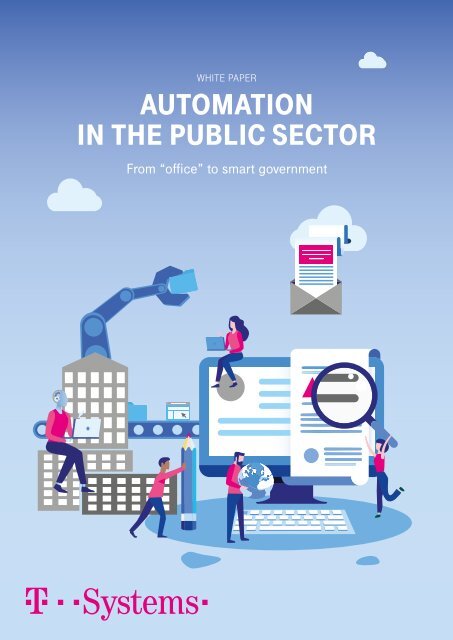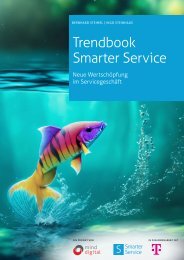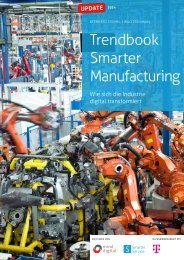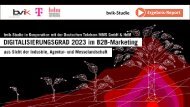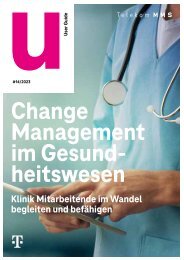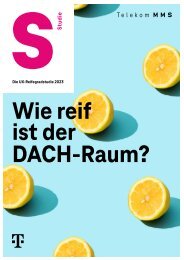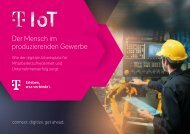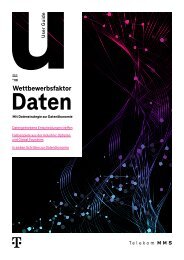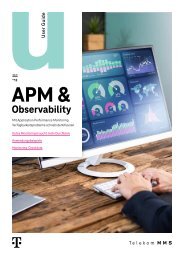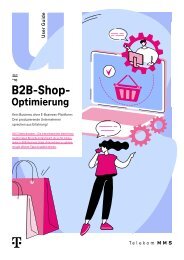Automation in the Public Sector
- No tags were found...
Create successful ePaper yourself
Turn your PDF publications into a flip-book with our unique Google optimized e-Paper software.
WHITE PAPER<br />
AUTOMATION<br />
IN THE PUBLIC SECTOR<br />
From “office” to smart government
WHITE PAPER<br />
AUTOMATION<br />
IN THE PUBLIC SECTOR<br />
From “office” to smart government<br />
T-Systems International GmbH<br />
Hahnstraße 43d<br />
60528 Frankfurt am Ma<strong>in</strong>, Germany<br />
Authors:<br />
Markus Naaf<br />
Mart<strong>in</strong> Kle<strong>in</strong>sorge<br />
Dr Frank Rickermann<br />
Organisation:<br />
Project management: Christopher L<strong>in</strong>k<br />
Layout: Peter Brücker
AUTHORS<br />
MARKUS NAAF<br />
Markus Naaf is an IT graduate (RWTH Aachen) and has worked for<br />
T-Systems (previously debis Systemhaus) s<strong>in</strong>ce 1996.<br />
In his various roles, some of <strong>the</strong>m managerial, <strong>in</strong> development,<br />
project management and sales, he has acquired vast experience <strong>in</strong><br />
areas such as telecoms (bill<strong>in</strong>g, CRM, network plann<strong>in</strong>g, etc.) and<br />
<strong>the</strong> energy economy (smart grids, energy efficiency management,<br />
bill<strong>in</strong>g for energy, etc.). As Senior Expert Sales Manager, he has been<br />
work<strong>in</strong>g for several years now on issues connected with smart cities<br />
and regions, particularly focus<strong>in</strong>g on <strong>in</strong>novative eGovernment solutions at local and federal<br />
state level. He believes that <strong>the</strong> extensive digitalisation of adm<strong>in</strong>istration processes is one of<br />
<strong>the</strong> keys to ensur<strong>in</strong>g that Germany has <strong>the</strong> competitiveness and flexibility to meet <strong>the</strong> needs of<br />
<strong>the</strong> global economy and social development. Markus Naaf has been a member of <strong>the</strong> German<br />
Informatics Society (GI: Gesellschaft für Informatik) s<strong>in</strong>ce 1984.<br />
Tel.: +49 171 8643 587, email: markus.naaf@t-systems.com<br />
MARTIN KLEINSORGE<br />
Mart<strong>in</strong> Kle<strong>in</strong>sorge MA studied philosophy, psychology and economics.<br />
As an Executive Consultant, he helps clients design <strong>the</strong>ir IT and<br />
bus<strong>in</strong>ess processes. He has accrued 20 years of project experience,<br />
result<strong>in</strong>g <strong>in</strong> an <strong>in</strong>-depth knowledge of <strong>in</strong>dustry standards and <strong>the</strong> ability<br />
to employ a great deal of creativity when advis<strong>in</strong>g on processes. In a<br />
secondary role, he is <strong>in</strong>volved <strong>in</strong> upgrad<strong>in</strong>g <strong>the</strong> digital portfolio for <strong>the</strong><br />
public sector. He would love to see us get Germany back to <strong>the</strong> top of<br />
<strong>the</strong> EU digitalisation rank<strong>in</strong>g!<br />
Tel.: +49 177 4401 115, email: mart<strong>in</strong>.kle<strong>in</strong>sorge@t-systems.com<br />
CONTENTS<br />
1. INTRODUCTION 6<br />
2. A CUSTOMER JOURNEY 8<br />
3. CURRENT SITUATION AND AIMS 12<br />
4. PROCESS AUTOMATION 14<br />
4.1 The hub: <strong>the</strong> automation platform 14<br />
4.2 Integration components 17<br />
4.3 Robot-controlled process automation 21<br />
4.4 Data orchestration as a service 22<br />
5. PROCESSES, DATA, IOT MANAGEMENT 24<br />
5.1 Smart government as part of a smart service <strong>in</strong>frastructure 24<br />
5.2 IoT service management 25<br />
5.3 <strong>Public</strong> data under <strong>the</strong> Open Data Act 27<br />
6. DATA PROTECTION AND LEGAL ISSUES 29<br />
6.1 Social data and <strong>the</strong> cloud 29<br />
6.2 <strong>Public</strong> “on-premises” data 30<br />
6.3 Separately encrypted public data 30<br />
6.4 Fully automated adm<strong>in</strong>istrative decision-mak<strong>in</strong>g 31<br />
DR FRANK RICKERMANN<br />
Dr Frank Rickermann has a PhD <strong>in</strong> physics and has worked for T-Systems<br />
<strong>in</strong> various roles s<strong>in</strong>ce 1998. As Executive Programme Manager,<br />
he dedicates a high level of personal commitment to head<strong>in</strong>g up<br />
highly successful IT projects and programmes for clients <strong>in</strong> <strong>the</strong> public<br />
sector, <strong>in</strong>clud<strong>in</strong>g <strong>the</strong> BA (Federal Employment Agency), BaF<strong>in</strong> (Federal<br />
F<strong>in</strong>ancial Supervisory Authority), BAMF (Federal Office for Migration<br />
and Refugees), BDBOS (Federal Agency for <strong>Public</strong> Safety Digital Radio),<br />
BPOL (Federal Police) and BKA (Federal Crim<strong>in</strong>al Police Office).<br />
As Smart Government Tribe Lead, he is responsible for upgrad<strong>in</strong>g <strong>the</strong><br />
digital portfolio for <strong>the</strong> public sector. This covers cutt<strong>in</strong>g-edge issues and technologies such<br />
as service platforms, process automation, RPA, AI/Edge, blockcha<strong>in</strong> and <strong>the</strong> latest consult<strong>in</strong>g<br />
formats such as co-creation. His motto is: success comes from work<strong>in</strong>g with <strong>the</strong> client.<br />
Tel.: +49 175 2410 836, email: frank.rickermann@t-systems.com<br />
7. DIGITISING ANALOGUE INPUTS 32<br />
7.1 The best strategy: avoid<strong>in</strong>g analogue <strong>in</strong>puts 32<br />
7.2 Incom<strong>in</strong>g correspondence: paper documents, faxes, email attachments 33<br />
7.3 Next: automat<strong>in</strong>g written replies 35<br />
7.4 A member of <strong>the</strong> public phones <strong>in</strong>: digital voice process<strong>in</strong>g 35
1. INTRODUCTION<br />
Until <strong>the</strong> 1990s, IT played a support<strong>in</strong>g role <strong>in</strong> <strong>the</strong> delivery of bus<strong>in</strong>ess processes, whereas<br />
nowadays IT is responsible for a much larger share of value creation, with automated trad<strong>in</strong>g<br />
be<strong>in</strong>g a prime example. Automated processes run more quickly and more accurately, and <strong>the</strong><br />
valuable “employee” resource can take on more <strong>in</strong>telligent, less rout<strong>in</strong>e tasks. <strong>Automation</strong> is<br />
not an end <strong>in</strong> itself; it has to keep pace with what is technically feasible and also with automation<br />
needs and pressures as realistically assessed.<br />
The motivations beh<strong>in</strong>d <strong>the</strong> desire for automation differ from sector to sector. As well as a<br />
shortage of skilled labour, companies and public authorities need to take <strong>in</strong>to account factors<br />
such as cost pressure, <strong>the</strong> need to modernise, <strong>the</strong> frenzy for regulation and <strong>the</strong> ability to<br />
compete. In this context, <strong>the</strong> need to rema<strong>in</strong> competitive, particularly for public authorities,<br />
tends to come from “competition between authorities” or from politicians deliberat<strong>in</strong>g whe<strong>the</strong>r<br />
to privatise authorities, or even commission companies to perform public sector duties as<br />
“entrusted agencies”.<br />
<strong>Automation</strong> does not necessarily have to be externally <strong>in</strong>duced. Whatever <strong>the</strong> extent of outside<br />
<strong>in</strong>fluences, a well implemented cont<strong>in</strong>uous improvement process <strong>in</strong> a company or public<br />
authority will ensure that processes run more effectively and efficiently and are smarter, which<br />
<strong>in</strong>evitably leads to more automation. Though exaggerated, <strong>the</strong> diagram below shows <strong>the</strong> work<strong>in</strong>g<br />
practice that is common <strong>in</strong> many companies and public authorities.<br />
<strong>Public</strong> authorities are more directly subject to politicians’ eagerness to <strong>in</strong>tervene than is <strong>the</strong><br />
case with companies via market regulation. With <strong>the</strong> OZG (Onl<strong>in</strong>e Access Act), for example,<br />
<strong>the</strong> state is committed to ensur<strong>in</strong>g that all adm<strong>in</strong>istrative services are also provided digitally<br />
(i.e. onl<strong>in</strong>e) by 2022 at national, federal state and local levels. In <strong>the</strong> course of implement<strong>in</strong>g<br />
<strong>the</strong> OZG, 575 services from <strong>the</strong> public adm<strong>in</strong>istration service catalogue (LeiKa) need to be<br />
digitised. However, this political pressure also offers opportunities:<br />
· Given this complex mix of <strong>in</strong>ternal and external <strong>in</strong>fluences, how can any automation of<br />
adm<strong>in</strong>istration processes, <strong>in</strong> <strong>the</strong> sense of smart government, succeed?<br />
· How can members of <strong>the</strong> public, municipal bus<strong>in</strong>esses and, <strong>in</strong> <strong>the</strong> context of economic<br />
fund<strong>in</strong>g, local companies be more closely <strong>in</strong>volved <strong>in</strong> adm<strong>in</strong>istration processes so that <strong>the</strong><br />
public and local companies do not feel excluded from adm<strong>in</strong>istrative activities?<br />
· How can <strong>the</strong>re be an adequate response to <strong>the</strong> challenges of automat<strong>in</strong>g processes with<strong>in</strong><br />
and between public authorities?<br />
· How can those <strong>in</strong>volved be offered cutt<strong>in</strong>g-edge digital services? After all, modern IT is also<br />
a key part of our lifestyle and everyday culture – <strong>the</strong> public and o<strong>the</strong>rs <strong>in</strong>volved do not want<br />
anyth<strong>in</strong>g that is <strong>in</strong>ferior to market standards from processes <strong>in</strong> <strong>the</strong> public sector.<br />
· How can <strong>the</strong> public adm<strong>in</strong>istration offer value-added services that, for example, come from<br />
supply<strong>in</strong>g mass public data (open data)?<br />
· How can process automations support new, more flexible work models?<br />
Work<br />
Emails, spreadsheets, forms, phone calls,<br />
unstructured data<br />
Departments<br />
This white paper sets out paths and solutions that can enable <strong>the</strong> transformation from traditional<br />
office to smart government to succeed through automation.<br />
Disruptions<br />
Enquiries<br />
Applications<br />
Jobs/Tasks<br />
Orders<br />
Sub-departments<br />
Purchas<strong>in</strong>g<br />
IT/Security<br />
HR<br />
F<strong>in</strong>ance<br />
The terms “automation” and “digitisation” are used synonymously to a certa<strong>in</strong> extent <strong>in</strong><br />
everyday speech, though sometimes one of <strong>the</strong> terms is encompassed with<strong>in</strong> <strong>the</strong> o<strong>the</strong>r. This<br />
document uses “digitisation” <strong>in</strong> its narrower, orig<strong>in</strong>al sense, i.e. mak<strong>in</strong>g th<strong>in</strong>gs that are analogue<br />
digital (forms/paper documents, sound/voice, images/code). <strong>Automation</strong> is thus <strong>the</strong><br />
more general term.<br />
Figure 1: Break<strong>in</strong>g away from traditional work<strong>in</strong>g practices. But how?<br />
6 7


